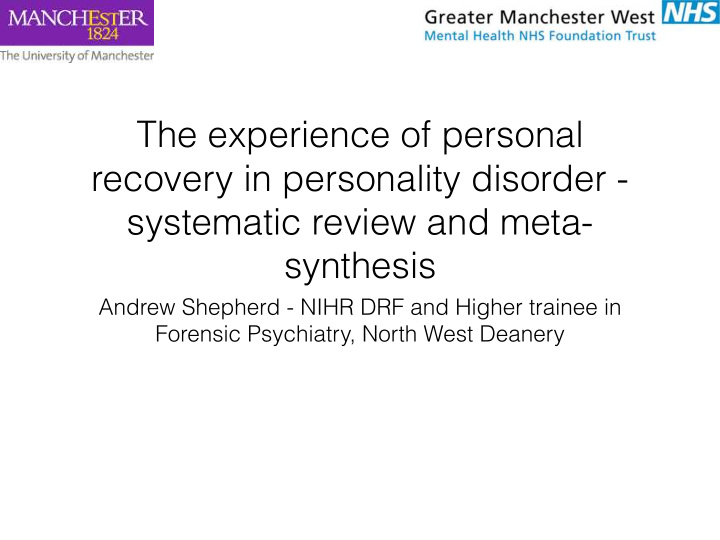



The experience of personal recovery in personality disorder - systematic review and meta- synthesis Andrew Shepherd - NIHR DRF and Higher trainee in Forensic Psychiatry, North West Deanery
Background Personal recovery “…a way of living a satisfying, hopeful, and contributing life even with limitations caused by illness.” [Anthony 1993, p527] • Accepting of ‘illness’ [?biomedical] • Rehabilitative framework
Background - personal recovery “The goal of the recovery process is not to become normal. The goal is to embrace our human vocation of becoming more deeply, more fully human.” [Deegan, 1996, p92] • No reference to ‘illness’ • Human process
Personal recovery - tension? • Role of ‘illness’? • Who defines? • How to offer support?
Personality disorder • Problematic - unclear nature with challenge to current classification systems? • How to make sense of idea of personal recovery in light of personality disorder?
Proposal • All accounts agree on idiographic nature of recovery experience • Therefore by focussing on experience of individuals we can better explore and contextualise the personal
Systematic review and meta- synthesis Aims Background sensitisation to literature: “To adequately map existing qualitative research literature relating to the experience of personal recovery in personality disorder”
Literature search Systematic literature search: 1. To identify qualitative methods literature 2. Personal experience of recovery 3. Excluding clinical recovery definitions 4. Requiring transparent involvement of primary material
Meta-synthesis Aim - To thematically map existing literature and develop higher order descriptive concepts Analogous to approach of Noblit and Hare (1988) 1. 1st order themes [participant quotations] 2. 2nd order themes [original author interpretation] 3. 3rd order themes [synthesised through coding and group discussion]
Results & Discussion Three studies meeting inclusion criteria Developed three overarching third order themes 1. Safety and containment as prerequisite to recovery 2. Social networks and personal autonomy in the recovery process 3. Identity construction as a process of change
Safety and Containment “…I can come in and cry. The important thing is that coming here makes you safe enough to change.” [Castillo, 2013]
Safety and containment Previous experiences of danger and invalidation (both personal and in professional settings) led participants to need a place of safety to allow change to begin.
Social networks and personal autonomy “It’s all about human contact. I think a lot of people here realise what it’s like to be lonely, we all know what it’s like…” [Castillo, 2013]
Social networks and personal autonomy ‘Turning points’ were described - where active choices to change were made. However these processes were recognised as occurring within a social setting - family and friend networks and the risk of tension with mental health services.
Identity construction “…’Your disorder is the reason why you try to kill and harm yourself.’ I stayed alive and for this I was grateful, but nobody saw me or spoke to me as a person.” [Holm, 2011] Goran Bogicevic / shutterstock.com
Identity construction Descriptions of effort to understand previous acts and behaviours. Varying interpretations of ‘illness’ were described - from accounts for behaviour through to rejection of stigmatising labels
Conclusions • Understandings of recovery can challenge clinical approaches to mental distress - including personality disorder • There is evidence that routinely used outcome frameworks do not match well with personal recovery aspirations [Andresen, 2009] • This review is limited by the small number of included studies and methodological limitations of these studies • Further work is required to better explore the personal experience of recovery in relation to personality disorder
References 1. Anthony, W. A. (1993). Recovery from mental illness: The guiding vision of the mental health service system in the 1990s. Psychosocial Rehabilitation Journal, 16, 521–538. 2. Deegan, P. (1996). Recovery as a journey of the heart. Psychiatric Rehabilitation Journal, 19(3), 91–97. 3. Noblit, G. W., & Hare, R. D. (1988). Meta-Ethnography: Synthesizing Qualitative Studies. SAGE Publications. 4. Holm, A. L., & Severinsson, E. (2011). Struggling to recover by changing suicidal behaviour: narratives from women with borderline personality disorder. International Journal of Mental Health Nursing, 20(3), 165–173. doi:10.1111/j.1447-0349.2010.00713.x 5. Katsakou, C., Marougka, S., Barnicot, K., Savill, M., White, H., Lockwood, K., & Priebe, S. (2012). Recovery in Borderline Personality Disorder (BPD): a qualitative study of service users' perspectives. PLoS ONE, 7(5), 1–e36517. doi:10.1371/journal.pone.0036517.t002 6. Castillo, H., Ramon, S., & Morant, N. (2013). A recovery journey for people with personality disorder. International Journal of Social Psychiatry, 59(3), 264–273. doi:10.1177/0020764013481891 7. Andresen, R., Caputi, P., & Oades, L. G. (2010). Do clinical outcome measures assess consumer-defined recovery? Psychiatry Research, 177(3), 309–317. doi:10.1016/j.psychres.2010.02.013
Acknowledgements Thanks to my supervisory team: Caroline Sanders Michael Doyle Jenny Shaw I am funded by a NIHR fellowship grant. Opinions expressed represent those of myself and co-authors, not necessarily those of the NIHR, NHS or DoH.
Recommend
More recommend